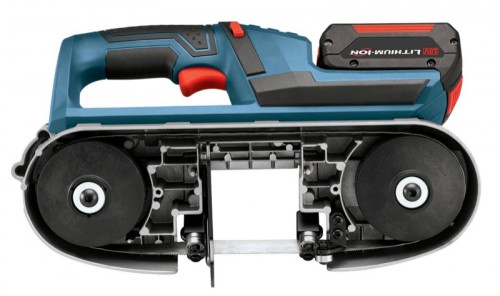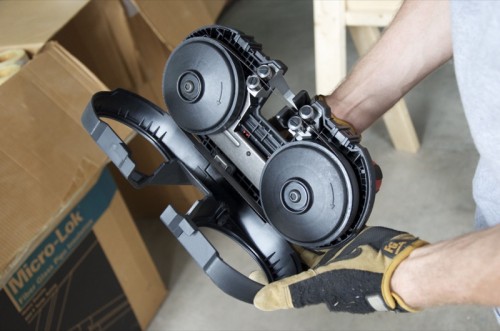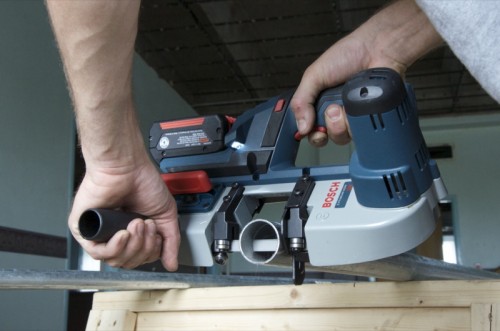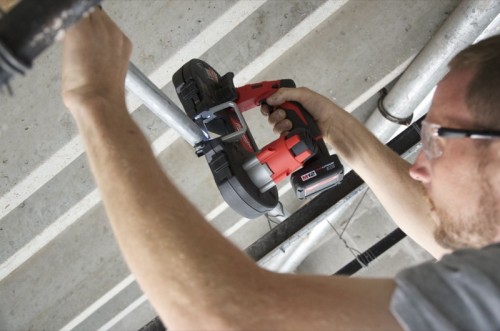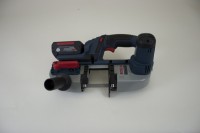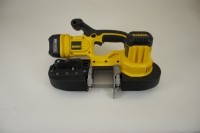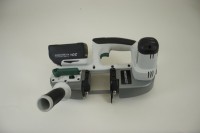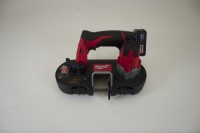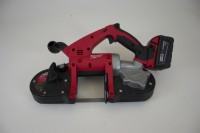Cutting a lot of conduit, all thread rod, small diameter plastic or metal pipe and strut channel are ideal opportunities to use a portable band saw. While this is not a new product category, I was really starting to see a rise in the popularity of the cordless versions among my peers. There seem to be two primary reasons for this. For one, the prices have been coming down, and these tools are more affordable than ever. But the second reason is that these tools are now rivaling the performance of their corded counterparts. With the expansion and development of lithium-ion battery technology, tools like band saws now have ample power and run-time on tap to handle heavy-duty use and abuse. Going cordless has other advantages too—like being able to go up a ladder or a lift. With no cords attached, this actually makes for a safer work environment. You eliminate a tripping hazard by eliminating the cord. I took a look at five different cordless band saws that are currently on the market to see what the differences were and which one might surface as being particularly noteworthy or even the best cordless band saws in their performance or features.
Why Band Saws?
Band saws are great for making clean smooth cuts because of their high speeds and thin blades. Unlike a reciprocating saw, there is no back and forth motion. That means that band saws are very easy to start into the material, and they cut very quickly. With a wide variety of blades available (with an equally wide variety of teeth per inch (TPI), it’s easy to optimize cutting speeds in the materials that you commonly work with.
Setting up the tools
All five of the band saws in this review have certain features that are common to all. The first I observed is that all of the blade tension systems work by means of a cam-lever on the free-spinning wheel. The saws are all pre-adjusted to give the optimum tension on the blade. They do this by way of an internal spring system that applies pressure on the pivot point of the free spinning wheel. The drive wheel is the one that is connected to the motor via gears or a shaft. All of the saws feature bearing guides at the point where the blade exits and re-enters the housing around the cutting area. Aside from the M12 Milwaukee, all the saws provide either built-in or removable second handles. This is key, since OSHA requires two hands on the band saw for proper use—with one notable exception. The M12 Milwaukee is allowed to be used one-handed, since its latching cover meets OSHA blade guarding requirements. It’s the only cordless band saw we’re aware of that truly gets around this provision, though at least one other company makes the claim.
Blades
While I could have ordered blades from a third party source to make sure that we had the same style tooth, TPI (teeth per inch) and thickness on each saw. Instead, I opted to stick with what came in the box so that the tool, as ordered, would be what we were testing. As I started to work on this review and talk to other professionals, I realized that some tradesmen would simply purchase replacement blades from the manufacturer. The others who would venture into custom replacement blades would need to vary the blades according to the required application. That could get complicated to test and also lose appeal to a lot of the users who will simply stick with the manufacturer’s recommended accessories. Just know that blade choice can affect cutting speed if you do not properly match up your blade to the material. For the sake of simplicity and practicality, all our testing used the blades which came with in the box with the band saws or replacement blades from the same source.
The Testing
As I thought about testing these saws, one thing became clear. Not all of these saws are created equal—or even designed to the same classification. They don’t all share the same battery capacity and they don’t all have the same cutting capacity. To even the playing field slightly, I decided to test cutting speed by using 1-1/2” EMT conduit, It was the largest size that would fit all the band saws, and it’s a pretty common material size that I see installed on commercial job sites. As I mentioned earlier, I went into this test knowing that each saw might have a slightly different TPI blade, but I decided to keep each tool “stock” from the manufacturer. To establish a cut speed, I locked the conduit in a vise and proceeded to make five individual timed through cuts—averaging all three and coming up with my time.
I also didn’t apply extra pressure to the saw, but allowed the weight of the saw to dictate the rate of cut. Besides, applying too much pressure to the back of the saw doesn’t necessarily speed up the cut, and it can actually cause extra stress and wear on both the tool and the blade. While my results did show which tools were the fastest out of the box, pro users in the field may experience different results when they optimize the tool with different blades. While I was testing the tools I took some time to verify the SFM (surface feet per minute) of the blade for each saw and compared each tool’s weight and size. All the values in the specification chart are based on my own testing, measurements and calculations, and so they may differ from the manufacturers’ numbers.
Surface Feet per Minute
When you’re dealing with band saws, you’re going to see a term pop up that isn’t as common with other types of power tools: surface feet per minute (SFPM or SFM). SFM is the imperial and American customary unit of cutting speed (or surface speed) in machining. It is a unit of velocity that describes how fast the cutting edge of the tool travels. This can be particularly important for when you want to establish the differences between products that might use the same blade style or teeth per inch (TPI).
In my EMT test, the big M18 Milwaukee band saw came in as the saw with the fastest cutting speed, taking just 1.9 seconds to make the pass. The M12 Milwaukee was the slowest with a time of 5.4 seconds. That makes for a 3.5 second spread from the fastest to the slowest tool. The DeWalt was the second fastest with the Masterforce and Bosch taking the remaining places.
INSET – How Fast Do These Saws Cut, Anyway?
To give you an idea of how fast these new portable band saws cut, I ran my tests against both a reciprocating saw and the fastest guy I know with a hacksaw: me. The bottom line is that not only do these cordless band saws cut faster that a recip saw or hacksaw—they do it without anywhere near the effort required to use other tools. Even the slowest saw in the test still cut more quickly though EMT than a recip saw.
-
Tool Time through 1-1/2″ EMT
(in seconds)Milwaukee M18 2629-22 1.9
DeWalt DCS370L 2.4
Masterforce 2410440 2.7
Bosch BSH180-01 3.2
Milwaukee M12 2429-21XC 5.4
Reciprocating Saw (14 TPI) 13.8
Hacksaw (21 TPI) 38.2
Bringing It All Down to Size
If you have to make any number of straight cuts in pipe, conduit, channel strut or even angle iron, then you’ll quickly learn the quickest and arguably the safest way to make these cuts is with a band saw. If you don’t “get” this tool, you probably don’t need it—and that’s OK. That just leaves more for the rest of us to fight over. After spending time with each of these saws, there are features I like about each of them. Some of you don’t care what I will say—you’ll still start with the brand with which you’re the the most familiar. If you have tools already on the same platform, that’s certainly a legit reason to sway one way or the other.
If, however, you want the biggest and baddest saw of the bunch, that would be the M18 Milwaukee. While it would be a great choice for day-to-day heavy-duty use, it also weighs the most at 10.5 pounds, besting the next saw by a full pound. The Dewalt DCS370L is a solid performer with a built quality that conveys toughness. If I was a kid, this saw would have been like my favorite Tonka dump truck…albeit a very dangerous, high speed, sharp Tonka dump truck. On a more serious note, this is the saw you want if you frequently need to hang the tool up while you’re reaching for something. It’s the only one with a rafter hook built right in.
The Master force 18V cordless band saw and the Bosch BSH180-01 are built off the same basic platform, but the Masterforce is easily the value leader, given its low bare tool price. We’ve also had one in the hands of one of the most tool-abusive electricians we know, and he hasn’t managed to break it in over a year. If you knew this guy you’d be impressed. The Bosch has a convenient work light and it offers 7/8″ greater cutting capacity over the Milwaukee M12—while adding just a few inches and about 23 ounces of weight.
The band saw with the most finesse is clearly the Milwaukee M12, whose sub-compact dimensions make it a truly unique cutting tool. Add to the that the ability to wield it one handed right underneath an OSHA inspector’s nose, and you’ve got something that will turn heads and save you time in the process.
At the end of the day, I’m pretty sure that any of these saws will make the job easier. If you’re still using a hack saw or a reciprocating saw you have got to upgrade—like this week.
Best Cordless Band Saws – Tool By Tool
Bosch BSH180-01
Despite its compact dimensions, the 18V Bosch BSG180 can jam material up to 2-1/2” diameter in its steel maw. I liked the cast aluminum base that securely housed the blade drive system. While the two piece blade guard is a nice gesture, I was perplexed at why they made me remove two small Philips head screws in the guard just to change the blade. What happened to ease of use? Because blade changes required this, Bosch got the distinction of being the only band saw in the lineup that was not entirely tool-free. Knowing how most contractors tend to work, I suspect that it’s only a matter for time before the guards get “lost” somewhere on a job site. This band saw uses the latest Bosch 18V battery system, so get the advantage of having built-in electronics to protect both the battery and the motor from overheating. The LED work light was a nice feature that made following cut marks easy in dimly lit areas. It also distinguished this tool from the Masterforce which lacked the light. This band saw is a sold performer with decent ergonomics.
Pros: Work Light, Compact dimensions
Cons: Difficult to remove blade guard, 1 year warranty
Verdict: Sturdy and compact, this band saw makes quick cuts in tight spaces.
DeWalt DCS370L
One of my favorite features on the DeWalt DCS370L band saw was the built-in rafter hook. As if it’s not bad enough these tools are kind of oddly shaped, imagine being on the top of a ladder trying to figure out a way to balance one of these on the step while you finish your work. Instead, having just finished an overhead cut, you can just hang the saw temporarily nearby. This simple little hook is a lifesaver—and it’s the simple things that make me happy. DeWalt’s DCS370L also has a tough feel to it and it was the second fastest saw in our quick cut test. While not the lightest saw in the lineup, the two handle positions make it very easy to maneuver. With the trigger handle located straight above the cutting area, the saw felt balanced when grasping it with one hand. I was a little disappointed to see the older post style battery, but I’m hoping to see an updated version in the near future based on the new, smarter 20V Max battery platform.
Pros: Built-in hanging hook, fast cuts, rugged
Cons: No work light, old post battery style
Verdict: Workhorse feel with rugged features and fast cuts.
Masterforce 2410440
While not as widely recognized, the Masterforce 2410440 band saw was the value leader in this lineup. On the outside it bears an uncanny resemblance to both the Bosch and Stout 18V band saws. After some time with this saw, I really like what you get for the money and the guard-free tool-less blade change is a real win. For most cuts, I found that I could live without a LED work light, but it’s a nice feature to have that was clearly missing. This saw was actually the second lightest in weight, third quickest in speed, and was still able to make 2-1/2” cuts. With a seriously low bare tool price ($99), it’s a no-brainer to add this band saw to your collection if you already have other Masterforce 18V or 20V tools. Given the value that this saw represents, there’s not much to complain about. The only disappointment with the 20V Masterforce 2410440 is that it’s only available at Menards, and, sadly, I don’t have one here on the east coast to visit.
Pros: Low Cost, good warranty, second lightest in line up
Cons: No work light, no back side blade guard, only available at Menards
Verdict: The best value for performance and price.
Milwaukee M12 2429-21XC
If you rarely cut material larger than 1-1/2” conduit or pipe and you do a lot of overhead work in tight spaces, the Milwaukee M12 2429-21XC is probably going to be your new best friend. Keep in mind that this is not a full size band saw replacement, but rather one that is ideal for portability. This little saw’s claim to fame is that it is the most compact and lightest cordless band saw on the market. And it really is. It was designed for single hand use from the beginning and its balance is superb as a result. The fact that OSHA can’t get you for not using two hands on this saw should make you smile a nice rebellious smile as you make your overhead cuts. I really appreciated the hinged back blade guard. Release two sliding tabs and you can fling it open, making blade changes swift and easy. Like their 18V saw, the M12 model comes in a nice blow molded hard case and is available as a bare tool version for just $139. Add the company’s 5-year warranty and this is one sweet little saw.
Pros: Low kit price, compact, one-hand use, excellent warranty
Cons: Limited to 1-5/8” diameter cuts
Verdict: The dainty but handy OSHA-approved one-handed band saw.
Milwaukee M18 2629-22
The Milwaukee M18 2629-22 is my favorite cordless band saw if I had to pick one for heavy duty use. With a 3-1/4” cut capacity and the fastest overall cut times for our 1-1/2” EMT conduit test, choosing this saw as an everyday workhorse is easy. The pulley guard is made of a high impact polymer that can withstand drops on its end, and the gear case is cast aluminum to help ensure long gear life and job site abuse. Milwaukee chose to change-up the typical direct-drive motor design to one that is more like a worm drive circular saw. The motor is positioned perpendicular to the axis of the drive wheel, which helps make for a really narrow profile. The tool-free adjustable material shoe easily moves up and down to allow flush cuts when working with conduit or pipe that’s against a wall or the ceiling. I also liked the blade eject feature and the built-in work light. Of course, all this performance comes at a cost, and the M18 was the most heavy, the largest and the most expensive band saw in our review. The 2629-22 comes packaged in a heavy-duty hard case with two XC batteries.
Pros: Fast, 3-1/4” cut capacity, Flush cut, 5-year warranty
Cons: Heavy and expensive
Verdict: If you want the biggest and the fastest, this cordless band saw will fit the bill.


